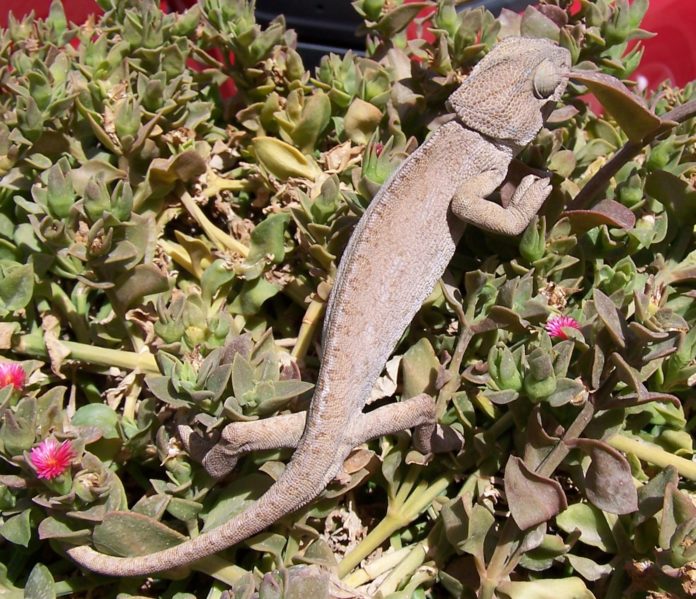
By David Jackson
There’s a little reptile that competes with the tortoise in our affections, but unlike its shelled cousin it is quietly conquering the province – the common chameleon.
It’s not an animal that leaps to mind when you think of Almería, but Chamaeleo chamaeleon is breeding like crazy and can now be found in places where it never existed before.
And with the chameleon breeding season upon us, if there are any nearby you’re bound to spot one soon.
Emilio Gómez of the Almería society for the study and recuperation of biodiversity (Serbal) has carried out an annual census of the provincial chameleon population since 2012. He says that there is no doubt that every year the breeding habitat of the species has expanded in the province. From its original colonies in Aguadulce, Carboneras and Roquetas specimens can now be found as far east as Mojacar and as far west as Adra, and is also common in the valley from Almería city up towards Granada. A survey just outside Aguadulce counted a density of 130 chameleons per square hectare, the highest number recorded in the country.
The lizard is believed to have come over from north Africa with settlers hundreds or even thousands of years ago, and found the dry coasts of Málaga to its liking.
The species was unknown in the province of Almería until a 1960 study established a breeding population in Aguadulce. In 1977 scientists released 40 breeding pairs into the Punta Entinas nature park to study their acclimatization, and at the end of the 1980s a further breeding population was established outside Carboneras.
What scientists don’t know, is why they have suddenly started breeding in such numbers. The breeding populations were almost static until 2005, when the lizards suddenly started to be found all over the place.
Local biologists suspect that warmer winters and greater insect numbers is allowing the species a longer breeding season combined with less competition for food. The chameleon is highly territorial during the breeding season, and this helps to push out the young to conquer new territories.
Wide ranging studies in 2001 and 2009 both confirmed that the species can be found throughout the southern Mediterranean coastline as far as Turkey, but that the Andalusian coastline is by far the most important breeding space for them.
Sr Gómez says that at this time of the year his association is inundated with calls from well meaning members of the public asking what to do with chameleons they have found. His advice? Leave them alone! “Unless they are in immediate danger, on a main road or the victim of a cat or other predator, you should leave them alone,” he advises. “They are very adaptable creatures. At the very most you can put them into a nearby tree or shrub out of the way of danger. If you find an injured one you can call the environmental police Seprona on 062. At this time of the year they are out and about, hunting for mates, and are at their most visible.”
Seprona can also be contacted if any injured wild animal is found in the countryside.
The species is specifically mentioned in a national protection law and cannot be hunted, captured or displayed. They are also protected under regional law forbidding the harming of animals. The chameleon is classified as in moderate risk of extinction, mainly due to human intrusion upon their limited habitat.
Despite this, they are well known as they have little fear of humans and will happily allow themselves to be plucked from a branch.
The animal is famous for its sudden changes in skin colour. Masó and Pijoan ran a series of experiments in 2011 which describe how the common chameleon has a colour range from clear yellow to black, passing through shades of brown, green and grey. Females have a greater range than males. Both sexes can achieve simple patterns, probably to confuse predators. But this lizard doesn’t just use its colour changes to hide. Instead, it mainly uses its pigmentation changes to attract mates, or to help control its body temperature – as a reptile, its only source of body heat is the heat of the sun.
Sr Gómez warns that their principle threats come from humans and pets. The main cause of death for the reptiles appears to be from getting run over on roads, closely followed by domestic cats and the illegal capturing of specimens by people who want to keep them at home.
But the chameleon seems to be well at home in the province and the chances you’ll find one near you just keep getting better. If you do find one, then you know what to do – enjoy it from afar. And don’t worry, you’ll soon find another one.
Serbal has a website where anybody who spots a chameleon can let them know for their census. Send your spotting, along with a photo if possible, online at http://serbal-almeria.com/contacta-con-nosotros.






























